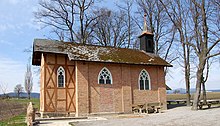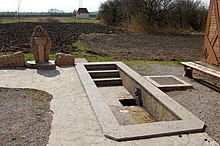Leobersdorf healing fountain
The Heilsame Leobersdorf wells located on the land line L 4040 to Sollenau in the market town Leobersdorf in district Baden in Lower Austria . The water of the spring , which has now dried up , was said to have healing powers, which is why it and the specially built Marienkapelle are still the destination of pilgrims from the surrounding communities today. When the water flow stopped in 1970, a connection was made to the nearby pumping station of the water pipeline association.
history
The spring is mentioned for the first time in 1466 as the "Heylige Prunn" in the Enzesfeld Urbarium of Christoph von Spaur, and settlement remains from the Bronze Age point to a remote place called Pölla , which was located in the vicinity of the well. However, the spring must have been buried, because its documented origin after a storm, in which, according to witnesses, the earth shook, is dated April 23, 1626.
The spring was first known because of its supposed beneficial effects, and even those who are about to die are said to have recovered. They mainly sought out people with eye diseases, a blind woman would have regained her eyesight and the son of Peter von Brauns (1758–1819), the landlord of Schönau an der Triesting , would have been cured of a serious eye disease.
The leakage of the spring helped the municipality of Leobersdorf to renew its weekly market rights through Emperor Ferdinand II. As a result, a wooden chapel with a bell was built over the spring from the proceeds of the offerings, which was destroyed in 1683 during the second Turkish siege of Vienna . It was restored, torn down during a storm in 1733 and rebuilt. In 1855 the wooden structure was replaced by a brick chapel. However, it remained without a measurement license . The Heilsame Brunnen became the goal of annual processional processions on Floriani Day (May 4th). On Sunday, May 30, 1926, around 1,000 believers celebrated its 300th anniversary after the church was renovated by the Leobersdorf community on the occasion of the anniversary.
Towards the end of the Second World War , the Marienkapelle was completely destroyed by Russian soldiers, but on May 13, 1945, 300 believers made a pilgrimage to the poorly repaired shrine. The solemn re-consecration took place that same summer. After a general renovation in 1990, the chapel was consecrated again on April 22nd.
Water quality
Between 1959 and 1966, the water of the healing well was examined by chief chemist engineer Rudolf Hock from Sollenau at different times of the year. The analyzes showed that the composition is similar to that of Vöslauer mineral water. The content of the slightly acidic water is largely constant, bottom sediments are not detectable. The outlet temperature is between 11.3 and 15.2 degrees Celsius. With 16.00 degrees of German hardness , the water is quite hard; it is enriched with chloride , sulfate and hydrogen carbonate ions.
literature
- Rudolf Hock: The healing well . In: Our home . Volume 38/1967. Association for regional studies of Lower Austria, St. Pölten 1967, OBV , p. 227–.
- Alois Schabes: The healing well . In: -: The Leobersdorf market - from the oldest time to the present . Marktgemeinde Leobersdorf (Ed.), Leobersdorf 1976, OBV .
Web links
- Sagen.at
- A vomited pilgrimage church. In: Deutsches Volksblatt / Deutsches Volksblatt. Radical medium-sized organ / telegraph. Radical Mittelstandsorgan / Deutsches Volksblatt. Daily newspaper for Christian German politics , morning edition, No. 4122/1900 (XII. Year), June 25, 1900, p. 4, center right. (Online at ANNO ). .
- What's new? (...) Panic in a church. In: Illustrirtes Wiener Extrablatt , No. 277/1903 (XXXII. Volume), October 9, 1903, p. 3, top left. (Online at ANNO ). .
- The murder at the "healing well". In: Triestingtaler and Piestingtaler Wochen-Blatt. Vöslau-Gainfarner Zeitung , No. 37/1933 (Volume IX), September 17, 1933, p. 5. (Online at ANNO ). .
Individual evidence
- ↑ Local news. (...) Leobersdorf. In: Triestingtaler and Piestingtaler Wochen-Blatt. Independent news bulletin of the Triesting- and Piestingtal and environs , No. 22/1926, May 29, 1926, p. 4, bottom right. (Online at ANNO ). .
Coordinates: 47 ° 54 ′ 36 ″ N , 16 ° 13 ′ 14 ″ E

